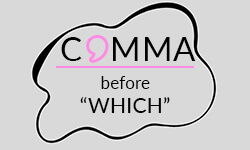
The proper use of commas is a common challenge for students, frequently resulting in errors and confusion in academic writing. This is due to a lack of knowledge regarding the rules and exceptions surrounding their usage. The purpose of this article is to provide clarification on the usage of commas before the conjunction “which”, with the aid of examples and an explanation of any exceptions to the rules.
When to place a comma before “which”
In general, there is only one rule when a comma must be placed before “which”. This is the case, when “which” introduces a non-restrictive clause. A non-restrictive clause is not essential to the meaning of a sentence and simply provides additional information.
Comma
Non-restrictive clauses
No comma
Restrictive clauses
“Which” after a preposition
Different Style Guides may have varying rules when it comes to using commas. In addition, certain complex sentences may have exceptions to the standard comma placement rules. It’s important to keep in mind whether a comma is necessary to ensure that your sentence is easy to read and understand.
Comma before “which”
When the word “which” introduces non-restrictive clauses, a comma is necessary before “which.” This goes without saying, but if “which” is part of a parenthetical expression, a comma is also needed before the conjunction. However, it should be noted that non-restrictive clauses are parenthetical expressions a lot of the time.
Non-restrictive clauses
When a non-restrictive clause is introduced by “which,” a comma should be used to separate the non-essential information from the main sentence. This helps to clarify the relationship between the main clause and the non-restrictive clause, making the sentence more readable and easier to understand. If a “which” clause can be removed from a sentence without altering its fundamental meaning, it is considered non-restrictive.
No comma before “which”
Generally, no comma is placed before “which” if the word introduces a restrictive clause or if it is written after a preposition.
Restrictive clause
Sometimes, “which” is used to introduce a restrictive clause. This clause is necessary to express the sentence’s meaning and define what you are referring to. Removing it would make the meaning unclear or less specific. It’s important to note that restrictive clauses should not be separated by commas.
Here, it is important to note, that the context helps decide whether a comma should be placed before “which.” If it’s essential information, you do not put a comma before the “which.”
“Which” after a preposition
In cases where “which” follows a preposition, a comma is usually not needed. This is because the prepositional phrase and the clause create a unified meaning and are closely linked.
Special case: Comma after “which”
Generally, it’s incorrect to use a comma after “which.” There’s typically no need to do so. The only situation where you should include a comma after “which” is when it’s followed by an interrupter. An interrupter is a phrase that breaks up the sentence to clarify or stress a particular aspect of the statement. Interrupters should be separated with commas on both sides.
Test yourself!
Practice sheet
To test your comprehension of using commas before “which”, try placing them in the appropriate positions in the 10 sentences. Afterward, check the second tab to verify if you have the correct understanding.
- My aunt’s house which is in Boston is quite spacious.
- The poetry which I like best is from the Romantic era.
- Jan visited Vietnam last year before which he had never travelled outside Europe.
- The new policy leads to misunderstandings and conflicts which helps nobody.
- I’m not sure which way to go.
- I have two bananas left which is enough for banana bread.
- Basset hounds which were first bred in France always have a white tip on their tails.
- We heard three speeches the longest of which went for an hour.
- The platform on which we built our programme is very stable.
- I asked Sam which bus I should take.
- My aunt’s house, which is in Boston, is quite spacious. (Comma)
- The poetry which I like best is from the Romantic era. (No comma)
- Jan visited Vietnam last year, before which he had never travelled outside Europe. (Comma)
- The new policy leads to misunderstandings and conflicts, which helps nobody. (Comma)
- I’m not sure which way to go. (No comma)
- I have two bananas left, which is enough for banana bread. (Comma)
- Basset hounds, which were first bred in France, always have a white tip on their tails. (Comma)
- We heard three speeches, the longest of which went for an hour. (Comma)
- The platform on which we built our programme is very stable. (No comma)
- I asked Sam which bus I should take. (No comma)
- ✓ 3D live preview of your individual configuration
- ✓ Free express delivery for every single purchase
- ✓ Top-notch bindings with customised embossing

FAQs
There are three simple rules to remember:
- A comma is placed before “which” when introducing a non-restrictive clause.
- No comma is used before “which” when introducing a restrictive clause.
- A comma after “which” is never used unless the word is followed by an interrupter.
Determine whether the clause introduced by “which” is restrictive or non-restrictive. If it is non-restrictive or part of a parenthetical expression, use a comma before “which.” If it is restrictive, no comma is needed.
Yes, you use a comma before “which” in one case: when it introduces a non-restrictive clause. In other cases, when “which” introduces a restrictive clause, you do not use a comma before it.
